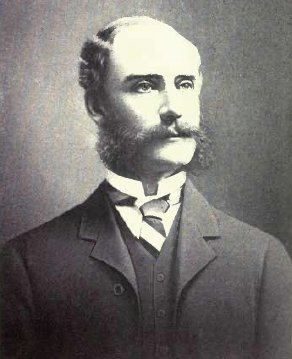Parkland Memorial Hospital is a hospital in Dallas, Texas, United States. It is the main hospital of the Parkland Health & Hospital System and serves as Dallas County's public hospital. It is located within the Southwestern Medical District.

Sophia Theresa "Sophie" Pemberton or Sophie Pemberton Deane-Drummond was a Canadian painter. Despite the social limitations placed on female artists at the time, she made a noteworthy contribution to Canadian art and, in 1899, was the first Canadian woman to win the Prix Julian from the Académie Julian for her portraiture. She was a near contemporary of Emily Carr, and the two artists spent much of their lives in the same small city.
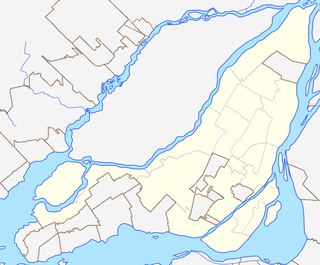
The Royal Victoria Hospital (RVH), colloquially known as the "Royal Vic" or "The Vic", is a hospital in Montreal, Quebec, Canada. It forms the biggest and base hospital of the McGill University Health Centre (MUHC), which is affiliated with McGill University. The hospital was established in 1893 and was based at Pine Avenue, now known as the Legacy site, until 2015, when major hospital operations were moved to the Glen site, named for the former Glen railway yards.
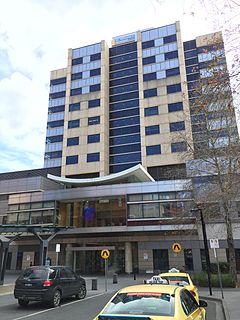
St Vincent's Hospital is a major hospital in Fitzroy, Melbourne, Australia.
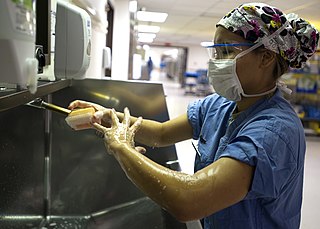
Asepsis is the state of being free from disease-causing micro-organisms. There are two categories of asepsis: medical and surgical. The modern day notion of asepsis is derived from the older antiseptic techniques, a shift initiated by different individuals in the 19th century who introduced practices such as the sterilizing of surgical tools and the wearing of surgical gloves during operations. The goal of asepsis is to eliminate infection, not to achieve sterility. Ideally, a surgical field is sterile, meaning it is free of all biological contaminants, not just those that can cause disease, putrefaction, or fermentation. Even in an aseptic state, a condition of sterile inflammation may develop. The term often refers to those practices used to promote or induce asepsis in an operative field of surgery or medicine to prevent infection.
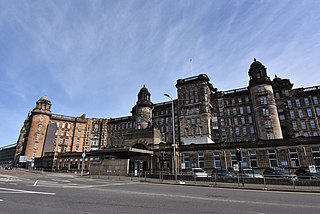
The Glasgow Royal Infirmary (GRI) is a large teaching hospital. With a capacity of around 1,000 beds, the hospital campus covers an area of around 8 hectares, situated on the north-eastern edge of the city centre of Glasgow, Scotland. It is managed by NHS Greater Glasgow and Clyde.
Interior Health is a regional health authority in British Columbia. It is one of the five publicly-funded regional health authorities, serving the southern Interior region of British Columbia.

Island Health, also known as the Vancouver Island Health Authority, is the publicly funded health care provider in the southwestern portion of the Canadian province of British Columbia. It was established as one of five geographically based health authorities in 2001 by the Government of British Columbia.

Vancouver Coastal Health (VCH) is a regional health authority providing direct and contracted health services including primary, secondary, tertiary and quaternary care, home and community care, mental health services, population and preventive health and addictions services in part of Greater Vancouver and the Coast Garibaldi area.
The Fraser Health Authority (FHA) is one of five publicly funded health care regions into which the Canadian province of British Columbia (BC) is divided.

Fisgard Lighthouse National Historic Site, on Fisgard Island at the mouth of Esquimalt Harbour in Colwood, British Columbia, is the site of Fisgard Lighthouse, the first lighthouse on the west coast of Canada.

British Columbia Children's Hospital is a medical facility located in Vancouver, British Columbia, and is an agency of the Provincial Health Services Authority. It specializes in health care for patients from birth to 19 days of age, unless followed by a specialist team. It is also a teaching and research facility for children's medicine. The hospital also operates the Sunny Hill Health Centre for Children, which provides specialized services to children and youth with developmental disabilities aged birth to 19.
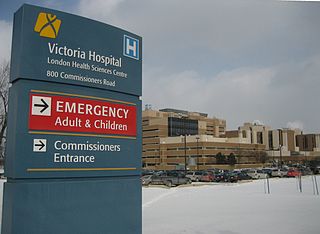
Victoria Hospital, in London, Ontario, Canada, is a large teaching hospital affiliated with the University of Western Ontario. Along with University Hospital it is part of London Health Sciences Centre, which itself is the Lead Trauma Hospital of the Southwestern Local Health Integration Network.

Queen Elizabeth II Health Sciences Centre, in Halifax, Nova Scotia, Canada, is a large teaching hospital and Level 1 Trauma Centre affiliated with Dalhousie University. The QEII cares for adult patients. Pediatric patients within the region are cared for at the IWK Health Centre. Administratively, the QEII is part of the Nova Scotia Health Authority.

The Royal Jubilee Hospital is a 500-bed general hospital in Victoria, British Columbia, Canada located about 3 km (1.9 mi) east of the city centre, in the Jubilee neighbourhood.

The Duke University Health System, combines the Duke University School of Medicine, the Duke University School of Nursing, the Duke Clinic, and the member hospitals into a system of research, clinical care, and education.
Richmond Hospital (RH) is a medical facility in Richmond, British Columbia, Canada. The Vancouver Coastal Health Authority (VCH) is responsible for Richmond Health Services and Richmond Hospital.
Compulsory sterilization in Canada has a documented history in, at minimum, the provinces of Alberta and British Columbia. In 2017, sixty indigenous women in Saskatchewan sued the provincial government, claiming they had been forced to accept sterilization before seeing their newborn babies.
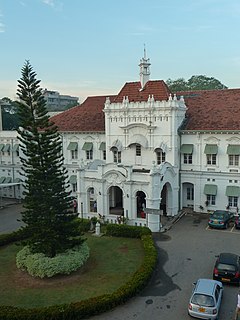
The National Hospital of Sri Lanka is a government hospital in Colombo, Sri Lanka. Founded in 1864 as the General Hospital, it is the leading hospital in Sri Lanka and is controlled by the central government. As of 2010 it had 3,246 beds. The hospital has 18 intensive care units and 21 operating theaters. It employs 7,500 staff of which 1,500 are doctors. The hospital carries out 5,000 major and minor surgeries each month and treats over two million out patients a year. Situated on a 36-acre site, it includes the Dental Institute, Maligawatte Kidney Hospital, Nurse's Training School, Post Basic Nurse's Training School, School of Eco Cardiograph, School of Physiotherapy, School of Radiography and the University of Colombo's Faculty of Medicine.
Pemberton Holmes Real Estate is a Canadian real estate company located in Victoria, British Columbia, Canada. It is considered one of the oldest family-owned real estate companies in North America; in continuous operation since 1887. The company was founded by Frederick B. Pemberton, a son of Joseph Despard Pemberton, who was responsible for the land surveying of the area.


